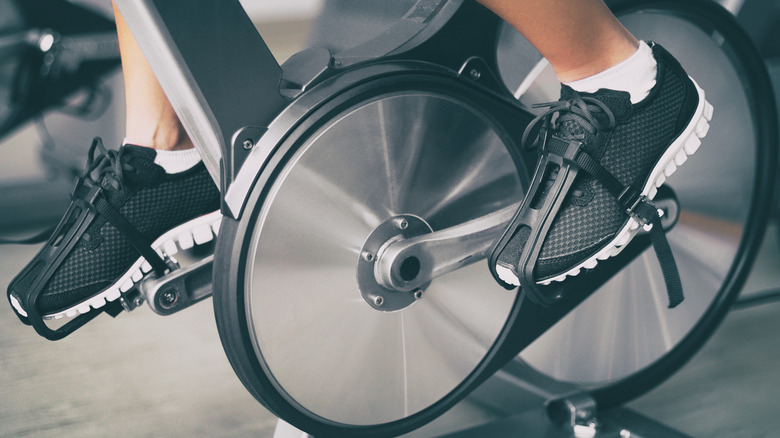When You Ride A Bike Everyday, This Is What Happens To Your Body
Regardless of where you are in your health journey, the benefits of cycling every day are undeniable. Along with being highly recommended as a low-impact option for beginners and those with underlying conditions, there are also countless ways to regularly work cycling into your schedule. Whether it's stationary indoor cycling, group classes, street cycling, or mountain and terrain biking, you can enjoy the benefits.
To start seeing benefits, Live Strong recommends adding 30 minutes of cycling to your routine daily. But before you start, speak with your doctor, especially if you have any underlying health conditions. Invest the time and money into quality equipment and the proper clothing. You should also adjust your bicycle to fit your height and proportions, which reduces the amount of stress on your body caused by bad posture and form.
Healthline recommends you research routes if you plan an outdoor ride. Specifically, look for local bike paths and bike lanes. In 2019, the National Security Council reported 1,089 cyclist deaths — up 6% — and 308,864 injuries. To protect yourself, spend time researching cycling-specific traffic laws to reduce the chances of a serious accident involving a vehicle.
Gentler on your joints
A key way cycling is different from other forms of exercise is its impact. Rather than being an exercise requiring your body to carry more of its own weight, particularly on the joints, biking allows for a great cardiovascular workout without so much physical toll. For many, exercises that put more exertion on the joints can be painful and at times even damaging. The American Public Health Association explained in their publication, The Nation's Health, that low-impact exercise like cycling provides the same benefits of higher-impact exercises, such as running, without as much risk.
Jacque Crockford, MS, CSCS, one of the American Council on Exercise's certified personal trainer and exercise physiology content managers, explained to The Nation's Health that low-impact workouts reduce your risk of musculoskeletal injury. Because it's safer, low-impact exercise is recommended for virtually everyone, even those with underlying issues that affect the joints like arthritis, as well as those who are pregnant.
Improved mental health and brain function
Many medical professionals frequently recommend working out as an effective way of improving mental health. Exercise continues to be a common recommendation for people looking to improve their mental health and brain function for good reason: it works, thanks mainly to the release of things like adrenalin and endorphins.
Endorphins, as clarified by Healthline, help you feel better and reduce stress, especially as they are released in tandem with adrenaline. While this is true of most exercises, cycling specifically has been proven to be an effective booster. Self reviewed a 2017 study of people who cycled to work. Those who participated reported feeling lower stress levels than those who used other commuter methods, such as driving or public transportation.
Cycling has been found to be particularly effective in older adults. In a 2019 study first published in PLoS One, cycling outdoors correlated with better cognitive function and well-being in aging populations.
Improved cardiovascular health
Arguably, one of the most crucial systems of your body, your cardiovascular system includes the engine of your body: your heart. Because it's low-impact cardiovascular exercise, cycling is an excellent way of improving your heart health without risk of overdoing it, meaning you can get the valuable heart-pumping workout you need without putting other parts of your body in jeopardy. The benefits are actually measurable.
In a University of Glasgow study of 260,000 people over the course of five years, researchers found cycling reduced a person's risk of heart disease by as much as 50%. Another 2017 study reported by Medical News Today found cycling was associated with a 52% lower risk of dying from cardiovascular disease.
In a 2019 MDPI-published review, researchers explained a likely reason for cycling's positive impact on cardiovascular health. The review explains that indoor cycling improves a person's aerobic capacity, allowing the cardiovascular system to more efficiently send oxygen to working muscles and for those muscles to use the oxygen more effectively.
Easier weight management
To maintain a healthy weight or to lose weight, you must burn as many or more calories than what you take in. Because cycling burns hundreds of calories per hour, depending on your weight and intensity, it's an effective way of increasing the number of calories you burn, according to Healthline.
In a 2018 study in the Journal of Education and Training Studies, researchers reported cycling can help reduce body fat while promoting weight management. These results are magnified when you combine your cycling routine with regular sprint and strength training, as shown in a 2020 study published by the Scandinavian Journal of Medicine and Science in Sports. In this study, researchers found that combining cycling everyday with sprint and strength training results in a temporary increase in metabolism and greater muscle building. As you build more muscle, more calories will be burned even when you're at rest.
Increased lung capacity
Taking a deep breath of air is something many of us often take for granted. But as soon as something interferes with that even slightly, it's easy to see why doctors recommend keeping an eye on your lung health. Things like quitting smoking and exercising, which works your lungs like any other muscle, can better your overall lung health. As you cycle regularly, your lung health will also improve. Published in the Scandinavian Journal of Medicine and Science in Sports, a 2011 study showed it only takes about 175-250 minutes of cycling per week to start to see "greatly" improved lung health.
Doctors are also finding cycling to be an effective and therapeutic option for those with underlying lung conditions already present. The European Respiratory Journal publication Breathe published a 2015 study illustrating that cycling can promote better lung function for those with lung conditions. One lung condition, in particular, was the focus of another 2016 study published in Breathe, that showed that cycling is a good option for patients with COPD.
Lower cholesterol
Once you reach a certain age, cholesterol becomes a regular topic of conversation with your doctor. Described by MedlinePlus as a "fat-like" substance present in your cells, cholesterol facilitates the production of vitamin D and aids in digestion. While everyone has at least a little cholesterol, when you have too much cholesterol buildup, specifically LDL, it begins to combine with other substances. This results in your body forming a plaque that accumulates in your arteries. Eventually, this will lead to heart disease and other cardiovascular complications.
As you lower your cholesterol, you reduce the risk of strokes and heart attacks, both associated with high cholesterol and heart disease. A 2019 study published by MDPI showed a link between cycling and an increase in HDL cholesterol, as well as reduced LDL cholesterol. Additionally, researchers noted a connection between cycling and lower triglycerides when you stick to a consistent exercise regimen.
Improved motor function and posture
As we age, we tend to lose balance, leading many health experts to recommend adding balance-focused exercise to our schedules. With much of our days spent at desks and more of our lives spent at computers or on the phone, the impact can be serious, even with one instance of tripping and falling.
With an increasingly sedentary lifestyle and this lowered sense of balance, Healthline suggests the chances of a fall or injury increase. Cycling is inherently rhythmic, based on hand-eye coordination done in steady movements while keeping yourself balanced. Self states this gives you the opportunity to continue practicing your balance and improve your coordination.
A 2015 study in the Journal of Physical Therapy Science confirms this theory. In the study, researchers found that cycling daily stimulates the motor regions in the central nervous system responsible for balance and coordination, while also activating the cerebral cortex, another area key to a strong sense of balance.
Lowered blood pressure
One of the first things a doctor or nurse will assess when you go in for an appointment is your blood pressure. By measuring your blood pressure, they are looking for evidence that your heart is pumping effectively and that your blood is flowing smoothly throughout your body. Exercise is one of the most effective ways to maintain a healthy heart and blood pressure. As you keep your blood pressure healthy, the chances of developing heart disease drop. Cycling has been shown to be an effective tool for keeping your blood pressure in a healthy range.
One2019 study showed regular cycling is associated with lower rates of high blood pressure. This was confirmed in the 2019 MDPI review, in which researchers found evidence that cycling could even be a primary therapy for reducing high blood pressure. After three months, blood pressure was reduced by 4.3% and after 10 months, it was reduced by 11.8%, in addition to the other benefits of cycling every day.
A stronger lower body
A popular form of resistance exercise lately is weight and strength training. However, that may not be the best option for those with underlying health conditions and if you prefer being outside, it can be a drag. Luckily, cycling involves natural resistance which helps build muscle. A higher percentage of muscle is connected with higher rates of calorie burning when a person is at rest. In a 2015 article published in PubMed, researchers found, especially when combined with the benefits of strength training, that cycling is an excellent way to accomplish muscle building and also improve lower body strength.
Healthline reminds us cycling is one of the joint-friendly ways of increasing strength in your lower body and leg muscles, namely because it targets and engages the quads, hamstrings, glutes and calves. You'll have the best results when you pair it with regular weightlifting exercises, like squats, leg presses, and lunges.
Increased core stability
As we age, our overall fitness level tends to drop as our lives become more sedentary. Yet our physical fitness can offset much of the negative effects of a less active lifestyle, like back pain developed from sitting at a desk all day or keeping your cholesterol levels lower. In a 2017 study, researchers found cyclists have a generally higher fitness level than those who don't cycle regularly. 90% of the study participants — all cyclists — were able to reach physical milestones recommended by health experts. One way cycling helps you achieve this higher level of fitness is through strengthening and stabilizing your core.
When cycling, be sure to sit tall while keeping your spine neutral, meaning it is neither arched nor hunched. This keeps you in proper cycling form, which engages muscles in your core, strengthening them while also improving your posture over time, according to Self.
Increased immune system function
No one likes getting sick, even if it's a simple cold. To combat seasonal bugs and sniffles, many turn to supplements and hygiene as their main form of defense. However, even with the best supplements and the most fastidious hygiene, you're forgetting a crucial step in the fight against infections. In the effort to fortify your immune system as much as possible, don't forget to add cycling. Aside from improving your overall health and wellness, cycling is also proving to be a clear component in maintaining your health when it comes to illness.
In fact, recent studies are showing promising results, especially when it comes to improving your ability to fight off respiratory illnesses. A 2020 study published by the Public Health Emergency COVID-19 Initiative, researchers found physical activity can strengthen the immune system in the fight against respiratory infections, like the common cold or COVID-19.
Deeper, more refreshing sleep
If you're having trouble sleeping, it may not only be the stress from work or family, but also your exercise habits. Exercise has long been tied to better sleep. In an interview with Johns Hopkins Medicine, Charlene Gamaldo, M.D., the medical director of Johns Hopkins Center for Sleep at Howard County General Hospital, said there is "solid evidence that exercise does, in fact, help you fall asleep more quickly and improves sleep quality."
To see the sleep benefits from cycling every day, it doesn't take a lengthy routine and years of practice. Johns Hopkins explains that taking 30 minutes for moderate aerobic exercise daily will make a difference in your sleep. Gamaldo echoed this, adding that "It's generally not going to take months or years to see a benefit and patients don't need to feel like they have to train for the Boston Marathon to become a better sleep."
Prevent and manage diabetes
The CDC defines diabetes as a chronic condition that primarily affects how your body converts food into energy, especially when it comes to simple carbohydrates and sugars. If unmanaged, diabetes can result in loss of limbs or even death in some cases. According to 2019 research, a regular cycling routine is linked to lower rates of diabetes. This confirms a 2016 study of Danish adults with the same findings. Scientists who published a 2017 study in the Journal of Clinical and Diagnostic Research could have the answer as to why. They found cycling is an effective way to lower blood pressure, even for those already living with Type 2 diabetes.
Regular cycling can also improve your outlook if you already have Type 2 diabetes. In 2021, researchers with JAMA Internal Medicine published their most recent findings: cycling consistently reduces the mortality rates for diabetes by as much as 24%. If you continue the routine for five years or more, it goes down by 35%.













